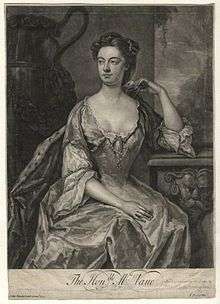Anne Vane
Anne Vane (died 27 March 1736), also known as "the Hon. Mrs. Vane," was a maid of honour to Caroline of Ansbach and mistress to her son Frederick, Prince of Wales.
Anne Vane | |
|---|---|
 | |
| Died | 1736 |
| Nationality | British |
| Known for | Royal mistress |
| Partner(s) | Frederick, Prince of Wales |
| Relatives | Henry Vane, 1st Earl of Darlington (brother) |
Life
Vane was the first daughter of Gilbert Vane, second Baron Barnard, and sister to the politician Henry Vane who was the first Earl of Darlington. Her mother, Mary (born Randyll), was described as "scandalous" by her father-in-law (i.e. Anne's paternal grandfather), Christopher Vane, 1st Baron Barnard, and it was thought that Anne may have followed her mother's example. Vane became the maid of honour to Caroline, Princess of Wales, and her son Frederick Louis, Prince of Wales presented her as his mistress and Vane entertained his guests at Soho Square.[1]
Vane's mother, Mary, died on 4 August 1728.[1]
Vane had a son and afterwards she recovered at St. James's Palace. It was well known that her son was named Cornwell Fitz-Frederick Vane. "Fitz-Frederick" means "child of Frederick", but Horace Walpole wrote that Lord Hervey and the first Lord Harrington each told Sir Robert Walpole that Cornwell was their son.[1]

In 1732 she was parodied in a number of works including a book titled The Secret History of the Beautiful Vanella. The poems' theme is her aristocratic lovers[2] and the ambiguous paternity of her children.[1] In 1734 Frederick and Anne were a couple, but in 1735 Prince Frederick was engaged to marry Augusta of Saxe-Gotha. It was originally proposed that Vane should be sent abroad but she managed to resist this and was still able to keep her pension of £1600 per year.[1]
In 1735 she moved to Bath. Her second child died the following year on 26 February 1736 in London, and Vane died in Bath, a few weeks later, on 27 March 1736.[1]
Legacy
There is an engraving of Mrs. Vane by John Faber Jr. after John Vanderbank.[3] It is said that "she was the model for Hogarth's Anne Boleyn in the picture of 1729".
Dr. Johnson wrote in the Vanity of Human Wishes: "Yet Vane could tell what ills from beauty spring;" referring to Anne, as distinct from her niece. His point is that "she generally ends her career betrayed, despised and distressed".[4]
References
- Matthew Kilburn, ‘Vane, Anne (d. 1736)’, Oxford Dictionary of National Biography, Oxford University Press, 2004; online edn, May 2008 accessed 19 Feb 2017
- The Fair Concubine: Or, The Secret History of the Beautiful Vanella [Anne Vane] Containing Her Amours with Albimarides [John Hervey, Baron Hervey] P. Alexis [Frederick Louis, Prince of Wales] &c ... To which is Annexed, The Lady's Last Shift; Or, A Cure for Shame ... W. James. 1732.
- Anne Vane, National Portrait Gallery, Retrieved 19 February 2017
- What Ills From Beauty Spring, Enotes, Retrieved 19 February 2017